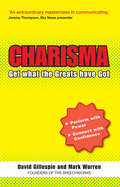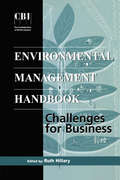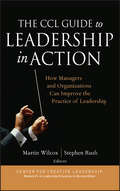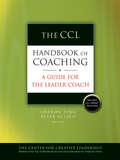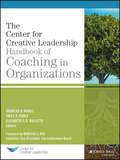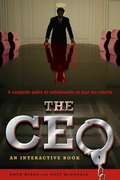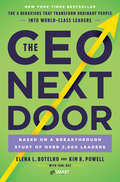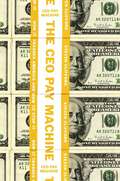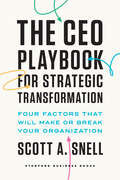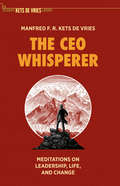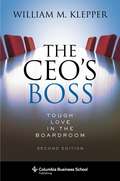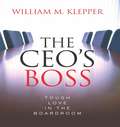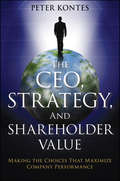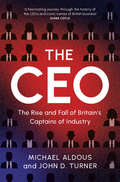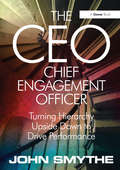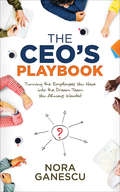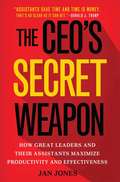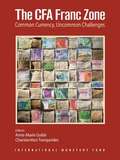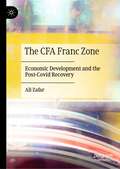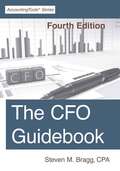- Table View
- List View
The C Student's Guide to Success
by Ron BliwasA very practical, step-by-step guide to career success for those who lack top grades or family connections. Some people graduate from college, and employers covet them: They are the best and the brightest, with stellar grades and great connections, able to land their dream jobs with major corporations right after school. This book is not for those people. In The C Student's Guide to Success, leading advertising executive-and former C student-Ron Bliwas presents a program of ten can't-fail principles for climbing to the top using your brains and talents-rather than family connections or fancy degrees. Bliwas uses real-world stories of business leaders, revealing how they identified and overcame their own weaknesses, and vaulted ahead of peers who had money and family connections. In surveying the come-from-behind success stories of his subjects, Bliwas provides creative, insightful, down-to-earth advice for new graduates, the recently employed, and those with a few false starts under their belt. In ten simple chapters, Bliwas teaches you how to: _ Make the most of many mentors _ Trust your instinct _ Strive to be a better person than employee _ Take responsibility seriously _ Master the art of purposeful learning _ Take advantage of unexpected opportunities _ Sell what you believe _ Go where the stars aren't _ Be a smart risk-taker _ Overcome straight-line thinking Bliwas encourages readers to embrace unconventional strategies, unexpected opportunities, and their own instincts, and to realize that opportunities for career growth exist everywhere-not just on the traditional path to job advancement.
The C Word: Charisma - Get What the Greats Have Got Ebook
by Mark Warren David GillespiePublic speaking, communication and presenting with power can all be terrifying prospects, however experienced you become, and cultivating a charismatic persona in our working lives is a priceless skill. This book is a humorous and incisive piece of observation by Dave Gillespie and Mark Warren which demonstrates the right and wrong level of status to adopt for our business lives. Whilst remaining fun, Charisma shows the reader how to tap into their own personal charisma and communicate with maximum impact.It studies a range of great communicators, from historical figures to modern day greats and highlights how their skills translate into what we call Charisma. Everyone from Franklin D Roosevelt, through Steve Jobs to Joanna Lumley is covered.A series of fun but practical exercises will help you to build your communication skills and use body language effectively.
The C Word: Charisma - Get What the Greats Have Got Ebook
by Mark Warren David GillespiePublic speaking, communication and presenting with power can all be terrifying prospects, however experienced you become, and cultivating a charismatic persona in our working lives is a priceless skill. This book is a humorous and incisive piece of observation by Dave Gillespie and Mark Warren which demonstrates the right and wrong level of status to adopt for our business lives. Whilst remaining fun, Charisma shows the reader how to tap into their own personal charisma and communicate with maximum impact.It studies a range of great communicators, from historical figures to modern day greats and highlights how their skills translate into what we call Charisma. Everyone from Franklin D Roosevelt, through Steve Jobs to Joanna Lumley is covered.A series of fun but practical exercises will help you to build your communication skills and use body language effectively.
The CBI Environmental Management Handbook: Challenges for Business
by Ruth HillaryA guide to all aspects of environmental management for businesses. The volume offers information on state-of-the-art techniques, trends and developments taking a user's perspective, capturing key viewpoints and drawing together best practice through the use of case studies. These display the practical implications of the topics under discussion and are set out to enable users to relate their information to their own experience.
The CCL Guide to Leadership in Action: How Managers and Organizations Can Improve the Practice of Leadership (J-B CCL (Center for Creative Leadership) #28)
by Stephen Rush Martin WilcoxThe Center for Creative Leadership (CCL) is the world’s premier institution devoted exclusively to leadership research and education. For more than three decades, CCL has worked with hundreds of thousands of executives to create practical models, tools, and publications for the development of effective leaders and organizations. This important collection is drawn from CCL’s long-running publication Leadership in Action. The guide examines the skills that you need to successfully give and receive feedback, make use of coaching, work with difference, deal with change, achieve work-life balance, and address the larger issue of expanding the leadership capacity of your organization.
The CCL Handbook of Coaching
by Sharon Ting Peter SciscoCoaching is vital to developing talent in organizations, and it is an essential capability of effective leaders. The CCL Handbook of Coaching is based on a philosophy of leadership development that the Center for Creative Leadership has honed over thirty years with rigorous research and with long, rich experience in the practice of leadership coaching. The book uses a coaching framework to give a compass to leaders who are called to coach as a means of building sustainability and boosting performance in their organizations. The book explores the special considerations that leader coaches need to account for when coaching across differences and in special circumstances, describes advanced coaching techniques, and examines the systemic issues that arise when coaching moves from a one-to-one relationship to a developmental culture that embraces entire organizations.
The CCL Handbook of Coaching in Organizations
by Douglas Riddle Elizabeth C.D. Gullette Emily R. HooleEffect better outcomes with a robust coaching program The CCL Handbook of Coaching in Organizations deals withthe practical, ethical, and political challenges of coaching withinan organization. From coaching superiors to coaching businessteams, this book outlines the Center for Creative Leadership (CCL)approach to professional coaching to help readers better manageleadership development and talent management program outcomes. Withexpert guidance on the key functions of human resources, learningand development, and organizational development, readers will gaininsight into the issues associated with coaching programimplementation and management, and the use of internal versusexternal coaches. Coverage includes a wide range of coaching-basedservices used in most large organizations, with practical advice oncreating the right programs for maximum impact within the availablebudget.Professional development is a hot topic and plays a key role inattracting and retaining the best talent. Coaching is a broad areawithin the field, encompassing a range of services and goals, withvaried expectations and requirements. This book provides actionableguidance for those designing, initiating, and implementing coachingprograms, with new approaches and techniques that drive betteroutcomes.Provide direct coaching within an organizationManage coaching systems and programsInitiate and lead mentoring and peer-coaching programsManage external coaches, and deal effectively with coachingsuppliersAn ideal coaching program must balance need with budget and betailored to the requirements and resources of both the organizationand the participants. It's a complex undertaking, but the rightstrategy and planning can lead to even better than expectedoutcomes. For the human resources professional who wants tostrengthen an organization's coaching program, CCL Handbook ofCoaching in Organizations is a thoughtful reference for aspecialized function.
The CEO
by Duff Mcdonald Owen BurkeYou're the boss.... Now make an executive decision. You are the CEO of Fleece Industries. So far, you've made all the right choices. The result: Your life's work -- building a company from an idea scrawled on a bar napkin into a clothing empire -- has reached a major milestone. Fleece is going to have an initial public offering and become a publicly traded company on the New York Stock Exchange. The instant the opening bell rings, you'll be worth tens, if not hundreds, of millions. It's a dream come true. Unfortunately that's when things get complicated. Now come the really hard choices. What would you do if You discovered that a rogue employee had been cooking the books? Your mistress threatened to expose your affair to your wife? You found yourself at the center of an insider-trading scandal? Your daughter turned up in a sex tape on the Internet? You found yourself considering the worst choice of all: MURDER? Step up to the plate. What would you do if you were The CEO?
The CEO Next Door: What It Takes To Get To The Top And Succeed, Based On The World's Most Comprehensive Leadership Study
by Tahl Raz Elena L. Botelho Kim R. PowellBased on an in-depth analysis of over 2,600 leaders drawn from a database of more than 17,000 CEOs and C-suite executives, as well 13,000 hours of interviews, and two decades of experience advising CEOs and executive boards, Elena L. Botelho and Kim R. Powell overturn the myths about what it takes to get to the top and succeed. Their groundbreaking research was the featured cover story in the May-June 2017 issue of Harvard Business Review. It reveals the common attributes and counterintuitive choices that set apart successful CEOs—lessons that we can apply to our own careers. Much of what we hear about who gets to the top, and how, is wrong. Those who become chief executives set their sights on the C-suite at an early age. In fact, over 70 percent of the CEOs didn’t have designs on the corner office until later in their careers. You must graduate from an elite college. In fact, only 7 percent of CEOs in the dataset are Ivy League graduates--and 8 percent didn't graduate from college at all. To become a CEO you need a flawless résumé. The reality: 45 percent of CEO candidates had at least one major career blowup. What those who reach the top do share are four key behaviors that anyone can master: they are decisive; they are reliable, delivering what they promised when the promise it, without exception; they adapt boldly, and they engage with stakeholders without shying away from conflict. Based on this breakthrough study of the most successful people in business, Botelho and Powell offer career advice for everyone who aspires to get ahead. Based on research insights illustrated by real life stories from CEOs and boardrooms, they tell us how to: - Fast-track our career by deploying the career catapults used by those who get to the top quickly - Overcome the hidden handicaps to getting the job we want. - Avoid the 5 hazards that most commonly derail those promoted into a new role. For everyone who aspires to rise up through the organization and achieve their full potential, The CEO Next Door is an essential guide.
The CEO Pay Machine: How it Trashes America and How to Stop it
by Steven CliffordThe former top CEO examines the scandalous and corrupt reasons behind obscene pay packages for corporate executives—and explains how this hurts all of us--and how we can stop it. Today, the pay gap between chief executive officers of major U.S. firms and their workers is higher than ever before—depending on the method of calculation, CEOs get paid between 300 and 700 times more than the average worker. Such outsized pay is a relatively recent phenomenon, but despite all the outrage, few detractors truly understand the numerous factors that have contributed to the dizzying upward spiral in CEO compensation. Steven Clifford, a former CEO who has also served on many corporate boards, has a name for these procedures and practices— "The CEO Pay Machine." The CEO Pay Machine is Clifford's thorough and shocking explanation of the 'machine'--how it works, how its parts interact, and how every step pushes CEO pay to higher levels. As Clifford sees it, the payment structure for CEOs begins with shared delusions that reinforce one other: Once this groupthink is accepted as corporate dogma, it becomes infinitely harder to see any decision as potentially irrational or dysfunctional. Yet, as Clifford notes, the Pay Machine has caused immeasurable harm to companies, shareholders, economic growth, and democracy itself. He uses real-life examples of the top four CEOs named the highest paid in 2011 through 2014. Clifford examines how board directors and compensation committees have directly contributed to the rising salaries and bonuses of the country's richest executives; what's more, Clifford argues, each of those companies could have paid their CEOs 90 percent less and performed just as well.Witty and infuriating, The CEO Pay Machine is a thorough and incisive critique of an economic issue that affects all American workers.From the Hardcover edition.
The CEO Playbook for Strategic Transformation: Four Factors That Will Make or Break Your Organization
by Scott A. SnellThere is no CEO task more significant than leading change in an organization whose old business model needs updating. Large-scale change involves rethinking how to engage customers, partners and suppliers with new technology and hard decisions about how to reorganize internal operations—plus the challenges of executing the transformation. The stakes are high, filled with risk and reward obvious to all...and it often fails. Why? Most organizations aren't built for change—they're designed for stability, scale, and repetition. Too many things can go wrong, from natural organizational resistance and inertia, to lack of strategic focus, to execution problems. And yet, organizations today must be more dynamic than ever before. Strategy is dynamic, not static, and requires agility, nimbleness, rapid resource deployment, and organizational change. This practical playbook helps CEOs and other key leaders reduce the risks and see through the overwhelming complexity of a major change in organizational strategy. Unlike many other books on leading change that focus narrowly on overcoming resistance, The CEO Playbook for Strategic Transformation offers a comprehensive framework involving 4 major tasks for leaders: 1) Establish and Communicate the Urgent Need; 2) Engage Stakeholders; 3) Mobilize the Organization; and 4) Develop Organizational Agility. Leaders who guide their organizations through these stages are far more likely to succeed than those who lack a playbook. Professor Scott Snell shares insights based on years of experience working with organizations undergoing change. He also provides a set of self-assessments, frameworks for action, and interventions to help senior leaders succeed at their most challenging and important task.
The CEO Whisperer: Meditations on Leadership, Life, and Change (The Palgrave Kets de Vries Library)
by Manfred F. Kets de VriesAt this critical junction in the history of humankind, leaders that are proficient in magical thinking aren’t going to solve our problems. Creating alternative realities is not the answer. We need a very different kind of leadership—leaders who can resist the calls of regression and whose outlook is firmly based in reality. We need leaders who analyze and draw conclusions from, or use their own experiences as a development tool, face their strengths and weaknesses, and critique their own experiences in order to build new understandings. In this very personal and entertaining book, Manfred Kets de Vries, one of the “gurus” in the field of leadership studies offers his thoughts on leadership and life, reflections written for executives and the people who deal with them. As a psychoanalyst and leadership professor let loose in the world of renowned global organizations—as a passionate educator and scholar, or just a human being at the receiving end of heart-rending emails—he examines the pitfalls of leadership and the challenges for the professionals who work with senior executives in today’s AI-focused world. He points out why leaders can derail, and what steps they can take to prevent this from happening. Ultimately, this book encourages you to “Know yourself,” but makes no bones about the challenge it represents. Understanding our “inner theatre” will always be an uphill struggle. Kets de Vries points out why deep dives into our inner world are always fraught with many anxieties. Included in the many subjects covered by the author are the loneliness of command, the management of disappointment, the destructive role of greed, the impact of stubbornness, the role of storytelling, the importance of wellness, and the role of corporate culture. In addition, the book addresses the important topic of how to create great teams and best places to work. Furthermore, the book touches on endings– the ending of our career and the growing realization of the inevitable ending of our life. As time grows short, Kets de Vries emphasizes that we have no time to lose in dealing with our anxieties, regrets, and the things we spend much of our life determined not to see. Taking a deep dive into self-knowledge requires courage and support, and he is here to guide you through it.
The CEO's Boss: Tough Love in the Boardroom (Columbia Business School Publishing)
by William KlepperThe CEO’s Boss, originally published in 2010, is the definitive guide to a productive working relationship between corporate boards and CEOs. Speaking to an era when company directors must monitor the actions and day-to-day operations of their CEO, William M. Klepper offers eight essential lessons to help boards operate more effectively in this bold and independent role. Since the publication of the first edition, Klepper has continued to develop and apply its lessons for a variety of businesses and settings.In this second edition, Klepper renews the paradigm set forth in the first, with new case studies of companies such as Wells Fargo, BP, Hewlett-Packard, and Proctor & Gamble. Giving directors, executives, investors, and stakeholders the tools to make crucial relationships work, Klepper details the best techniques for selecting the right CEO, establishing a working relationship, and giving effective feedback. He affirms the importance of the social contract between directors and their CEOs, encourages directors to embrace their independence, and teaches executives to value tough love. He revisits the first edition’s case studies and derives new insights from how these companies followed—or failed to heed—the book’s precepts. He also takes a close look at the predictions he made almost ten years ago, providing new forecasts and integrating core knowledge to ensure that The CEO’s Boss remains essential in our ever-changing business landscape.
The CEO's Boss: Tough Love in the Boardroom (Columbia Business School Publishing)
by William KlepperIn order to avoid another Enron, WorldCom, or Tyco, company directors have assumed a bold and independent role in the boardroom, monitoring the actions and day-to-day operations of the CEO. This dramatic shift has created a new dynamic, one that requires careful negotiation from both parties to get the job done. Giving directors, executives, investors, and stakeholders the tools to make this relationship work, William M. Klepper describes the best techniques for building a productive partnership and establishing a plan of action for a variety of businesses and settings.Klepper, an executive educator, has worked with AT&T, Bausch & Lomb, Johnson & Johnson, Sony, Sun Microsystems, and a host of other corporations. He knows what makes a healthy partnership between a board and its CEO and the consequences of a bad fit. In this book, he details the eight practices of successful executives, such as facilitating innovation, motivating change, and developing leadership skills, and he explains what directors need to evaluate, such as working style, social behavior, and the handling of stress, before they commit to hiring a CEO. The most critical element is the social contract, in which directors and their CEOs agree to be transparent, continually reassess their company's risk, maintain core company values, and make a commitment to their stakeholders. These include employees, shareholders, customers, and the community. In this essential volume, Klepper encourages directors to embrace their independence, and he teaches executives to value tough love.
The CEO's Guide to Marketing: The most practical marketing book you will ever read
by Lonny KocinaThe CEO's Guide to Marketing outlines a six-step process called Strategically Aimed Marketing, or SAM 6® for short. It will bring clarity to marketing like you've never experienced before. It's literally a step-by-step guide to more leads, higher sales and a stronger brand.
The CEO, Strategy, and Shareholder Value: Making the Choices That Maximize Company Performance
by Peter KontesA new look at delivering effective shareholder value from Peter Kontes, a true leader in the world of strategic management In The CEO, Strategy, and Shareholder Value, Peter Kontes, a true leader in the strategic management field, outlines the key to creating and growing shareholder value. The proper focus, contends Kontes, is in using quantitative measurements as guideposts on the path to success. The book first outlines the basics of the argument Kontes is making. He then briefly covers the five most important areas for business leaders, followed by a more detailed look at each of the focus areas. Finally, Kontes provides readers with a road map to implementing his suggestions. Presents an argument for a more holistic approach to delivering shareholder value Defines and then elaborates a new approach to strategic management Written by a true thought leader in the field, regularly featured in publications such as Fortune and BusinessWeek Never before have business leaders experienced the kind of tough decisions they are being forced to make as the economy undergoes incredibly rapid shifts. The common sense guide to successful leadership, The CEO, Strategy, and Shareholder Value delivers exactly the kind of solid, dynamic advice that will keep your organization moving on an upward path.
The CEO: The Rise and Fall of Britain's Captains of Industry
by John D. Turner Michael AldousThe CEOs of Britain's largest companies wield immense power, but we know very little about them. How did they get to the top? Why do they have so much power? Are they really worth that exorbitant salary? Michael Aldous and John Turner provide the answers by telling the story of the British CEO over the past century. From gentleman amateurs to professional managers, entrepreneurs, frauds, and fat cats, they reveal the characters who have made it to the top of the corporate ladder, how they got there, and what their rise tells us about British society. They show how the quality of their leadership influences productivity, innovation, economic development and, ultimately, Britain's place in the world. More recently, issues have arisen regarding high CEO pay, poor performance, and a lack of professionalisation and diversity. Are there lessons from history for those who would seek to reform Britain's flagging corporate economy?
The CEO: Turning Hierarchy Upside Down to Drive Performance
by John SmytheYou may be a senior executive wondering how to engage hundreds or thousands of employees in your vision, strategy or the transformation of the business; or a specialist in HR, communication and change, tasked with the challenge of 'aligning and mobilising' your people. In either case, you no longer want compliant people, you want individuals who will engage their creativity at work. For their part, engaged employees want a say in their work and in how the business changes. The Chief Engagement Officer explores a management philosophy which recognises the value of opening up decision making to the right groups to improve the quality of decisions and change, accelerate execution and broaden ownership. John Smythe asks what the concept of engagement means for employer and employee; tests whether and how it is different from internal communication and provides a practical framework for those who want to engage colleagues but need advice based on applied experience. The book includes a tapestry of reports from organisations who are engaging their employees to drive performance and change. The author demonstrates how powerful models, developed from his work at SmytheDorwardLambert, his time as an organisational fellow with McKinsey and Company, and his consultancy with Engage for Change, can be used to take this process forward in any organisation. The Chief Engagement Officer is a highly readable guide to the revolution that is needed in employee communication and organisational leadership from one of the most experienced and well-regarded experts on employee communication.
The CEO’s Playbook: Turning the Employees You Have into the Dream Team You Always Wanted
by Nora GanescuMany business leaders love their work and their company, but don’t know what else to do to get their employees to love it, too. Their employees may be good people; however, leaders who want their team to become brilliant together are facing roadblocks. In The CEO’s Playbook, Nora Ganescu shows businesses how to become that exciting and innovative workplace that creates one game-changing success after the other. She also understands the importance of key elements such as dedication, passion, and joy at work and teaches leaders how to instill these qualities within their employees. If running your company feels more like pushing a huge boulder up the mountain, then you are not alone. The CEO’s Playbook can help.
The CEO’s Secret Weapon: How Great Leaders and Their Assistants Maximize Productivity and Effectiveness
by Jan JonesMany executives don't take full advantage of the assistant who sits right outside their door. This book educates executives about all the ways in which they can streamline and improve the way they work with the help of a great assistant, while teaching them to identify great candidates and maximize the benefits of this special relationship.
The CFA Franc Zone Common Currency, Uncommon Challenges
by Anne-Marie Gulde Charalambos TsangaridesAbout one-third of countries covered by the IMF's African Department are members of the CFA franc zone. With most other countries moving away from fixed exchange rates, the issue of an adequate policy framework to ensure the sustainability of the CFA franc zone is clearly of interest to policymakers and academics. However, little academic research on the subject exists in the public domain. This book aims to fill this void, by bringing together work undertaken in the context of intensified regional surveillance, and highlighting the current challenges and the main policy requirements if the arrangements are to be carried forward. The book is based on empirical research by a broad group of IMF economists, with contributions from several outside experts. Fourteen African countries are members of the CFA franc zone. The long-standing link between the West and Central African CFA francs and the euro (and before that the French franc) has contributed to monetary stability in the region. Yet the CFA franc zone, like other fixed exchange rate regimes, must be mindful of sustainability and competitiveness. Diversity and relatively loose economic integration among member countries add to the challenges. In reviewing policy options for the zone, the authors of this volume suggest policies that would safeguard the benefits to member countries from the common currency, and at the same time promote more flexible economic systems to absorb shocks and increase the rewards stemming from regional integration.
The CFA Franc Zone: Economic Development and the Post-Covid Recovery
by Ali ZafarThis book provides an empirical analysis of economic and political structures impacting the CFA franc zone. Concise and practical chapters explore the history of the CFA franc zone, challenges to development, geopolitical issues, the importance of flexible exchanges rates, growth trends, and the impact of the Covid crisis. Policy reform is examined to detail economic approaches that could reduce poverty and increase the quality of life within the area. This book aims to present a macroeconomic and exchange rate framework to promote development and post-Covid recovery within the CFA franc zone. It will be of interest to students, researchers, and policymakers involved in African economics, the political economy, and development economics.
The CFO Guidebook
by Steven M. BraggThe CFO manages the financial structure and oversees the financial performance of an organization, so this is a critical and demanding management position. The CFO Guidebook provides the CFO with detailed advice regarding how to be most effective in every aspect of the job. <p><P>The book covers all parts of the CFO's traditional finance role, including budgeting, fundraising, investments, going public, investor relations, and share management. It goes on to address more recent additions to the job, such as strategic planning, risk management, the control environment, and information technology. Given its comprehensive coverage of the CFO position, The CFO Guidebook can serve as a reference manual for anyone wanting to become more effective in the position.
The CFO as Analyst and Adviser
by Jeremy HopeSurveys show that most CFOs want to upgrade their role from accounting specialists to strategic or business partners. But few CFOs have actually made the change, primarily because they have neither the time nor the necessary capabilities within the current finance team. But for those who do make the change, the rewards are tangible. This chapter lays out a number of important steps that the CFO and the finance team need to take to position themselves as trusted and valued business partners within the organization. This chapter is excerpted from "Reinventing the CFO: How Financial Managers Can Transform Their Roles and Add Greater Value."
The CFO as Champion of Change
by Jeremy HopeExpectations around the role of the CFO have greatly intensified in recent years. The CFO is now expected to be business generalist, risk management expert, and all-knowing source of business intelligence; to provide instant replies to any question the CEO asks about business performance; and to meet these challenges with lower costs. This chapter looks at the origins of the increased pressure on CFOs and explains why it is necessary for CFOs to break out of dysfunctional systems and mental models to redefine their role and the role of finance organizations. This chapter is excerpted from "Reinventing the CFO: How Financial Managers Can Transform Their Roles and Add Greater Value."

